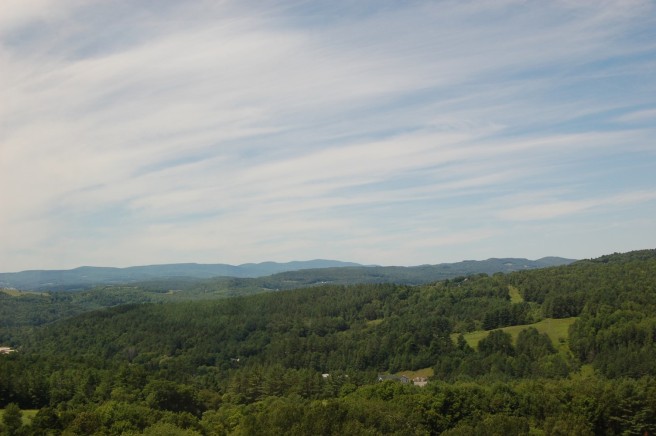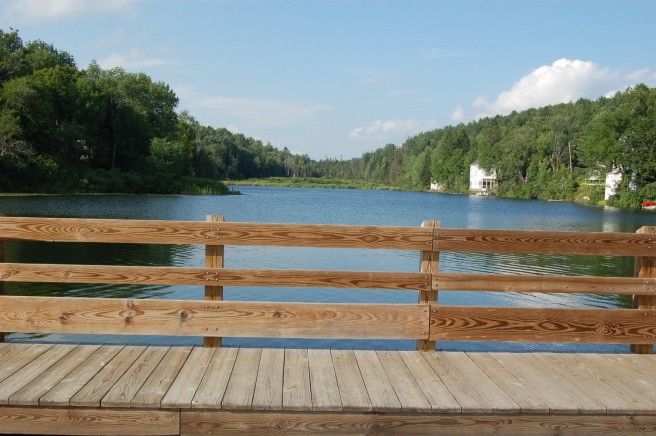
We quickly figured out why Vermont is called “The Green Mountain State:” It rained nearly every day we were there. And it rained a lot. Fortunately, we had a couple breaks in the weather and were able to venture outside long enough to see the area.







We chose to stay in Barre (“berry”), which has a population of about 8,000. The town is famous for its granite production. Offering some of the finest grain available, granite like Barre’s is renown for its durability in weather. Because of this Barre has been supplying grave markers and other granite products throughout the world for over 200 years. Unfortunately or not, mechanization of that industry has reduced the need for miners down to about six from 35 at one quarry, this according to our guide at the granite museum. This major dent to employment in a critical industry partially explains my next paragraph.



The first thing I noticed about the Barre and Montpelier area wasn’t its granite, but the fact that it appeared to be poorer than many of its northeastern neighbors. Vermont’s major industries are mining, fruit production and dairy farming (all lower-paying industries), yet Vermont citizens enjoy some of the highest taxes of any state in the union. So I suppose I shouldn’t have been shocked that some areas look poorer on average relative to other areas we’ve traveled. In comparison to our last Texas home, the median household income in Barre is $38,000 compared to $87,000 in McKinney. That’s not an insignificant difference in median household income, although I’m sure much of McKinney’s upside is the result of double-income couples in higher paying jobs. According to City Data and Zillow, state taxes in Vermont are 7-8%, while property taxes are nearly 2%. Contrast this with Texas, which has a similar property tax, but no income tax. The primary issue is that a higher relative tax burden is being placed on the lower paid people of Vermont. The other issue Vermont suffers from is population density, being 30th on the list and half as dense as Illinois, by example. This leads to higher cost of infrastructure per capita (per person). Our mining guide told us of a teacher he knows who pulls down $90,000 plus benefits to instruct a class of six! So, the appearance of “poorer on average” was easily borne out using available data at hand, and it should now be obvious why one particular senator thinks U.S. citizens as a whole should do more for the state of Vermont (as if they aren’t already, with Vermont third highest on the list of federal assistance takers among the country). The negatives of their economic situation aside, citizens of Vermont can enjoy endless mountain views and plenty of space in which to hike or ski.


I was sort of expecting that the state’s capital of Montpelier (pronounced “mont-peeler” very quickly), would be a sizable city, but it wasn’t. As it turned out, its population is only around 7,800. As such, we were able to easily see it in about five minutes of driving time.









We spent one afternoon looking at covered bridges. They are sort of tricky to find because the state isn’t compelled to call them out. You have to find them on the map, then find the roads leading to them on the map. I learned to spot signs at crossroads off the main route that posted “no loads greater than 10,000 (or, 16,000) pounds” as an indication that a covered bridge was nearby. All you have to do is then turn and follow the crossroad to the bridge. It also helps to keep tabs on which side of the road you are traveling on the river is so you know whether to look right or left.


Along the way to the covered bridges, we found Smuggler’s Notch. It represents the highest pass in the Green Mountain range. It was first put into use when Pres. Jefferson barred trade with Britain and Canada as a means of shuffling illegal goods between Vermont and Canada. It was put into later use for the same reasons during Prohibition.



On our way back from the covered bridges, we took time to go see Vermont’s only floating bridge, which passes over Sunset Lake. First opened in 1820, it is much like Grandpa’s ax in that it is has been rebuilt so many times that the latest iteration probably resembles nothing like the first. But it gave us something to do. The reason it floats is because Sunset Lake is too deep to accommodate ordinary supporting piers or piles. Apparently engineers have tried everything from floating logs to Styrofoam-filled barrels for flotation, with the latest design using replaceable, fiberglass pontoons. This eighth attempt was completed in 2015 and Brookfield, Vermont will get to see how well it lasts.





Our stay in Vermont occurred at a little mom-and-pop campground called Limehurst Lake. While it was nice enough, the lake wasn’t anything to write home about. Alayne walked around it in 20 minutes. It had too much algae for my tastes to consider swimming in it. This said, the campground appeared to be a great place for kids and families, and their Wi-Fi rocked.

While it was very-wooded and pretty, I didn’t find anything about Vermont that would cause me to ever go back for anything longer than a week or so. The area we were in lacked many of the conveniences I eventually require of any medium sized metropolitan area (upscale competitive grocery stores and a wide selection of decent restaurants within 10 miles, just to name a couple). After a week, I was ready to head toward upstate New York while watching Vermont fade into my rear view mirrors.

